Q&A – Ask Neil: August 1, 2024
(Please read these instructions carefully.)
Before you post your question, please look at recent issues to see if someone else has already asked it. You might find your answer there.
How to submit your question…
(Note: You may need to allow a pop-up window to come up in order to get the link for sending your photo(s). If you have already submitted your question and didn’t see the pop-up window, please click here.)
• Click the link provided below to post your question. After you submit your question, a new window will pop up giving you the address to which you can e-mail a SHARP, HIGH-RESOLUTION PHOTO to accompany your question. Please DO NOT SEND THUMBNAIL PHOTOS in case I need to zoom in to see things.
• Click here to post your question.
• Please ONLY POST YOUR QUESTION ONE TIME. We can only accept a set number of questions each week, and when we get duplicates it costs other people their chances.
• One question per reader, please.
• Please use this only for posting questions – not for standard emails.
• Watch for your answer in the following week’s e-gardens.
• I choose those of greatest general interest. For example, plant IDs seldom make the cut.
• I must have your first name or initials.
• I must have your city or county. (Texas is a very large state.)
QUESTION 1
IS THIS A CONCERN FOR OUR RED OAKS?
Question: We live in the Alliance area and I am wondering if we should be concerned about our 15-year-old trees as seen in the photos. Peggy S., Fort Worth.
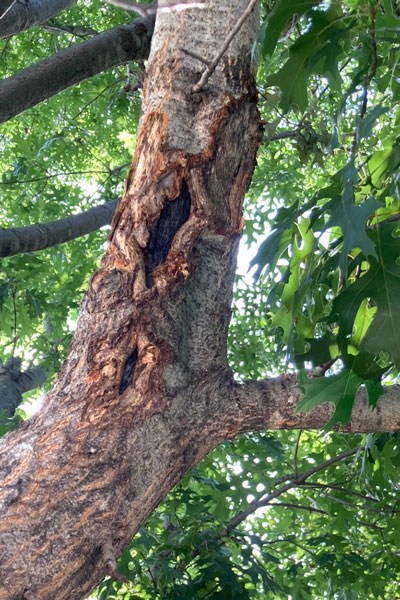
Answer: You used “photos” in the plural, yet I found only one. This tree has been attacked by some type of gnawing animal, almost assuredly a squirrel. They do this in an attempt to keep their teeth sharpened. From the rolls of new bark that are forming it appears that the tree is trying to heal. Other than some clean-up pruning to remove limbs that may be rubbing together, I see no need to do anything more. Remember to apply pruning sealant to all exposed cuts.
QUESTION 2
WHY IS MY CHINESE PISTACHIO TURNING YELLOW?
Question: Why is my Chinese pistachio turning yellow? The leaves have brown spots and are falling off. Mary Ann L., Alba.
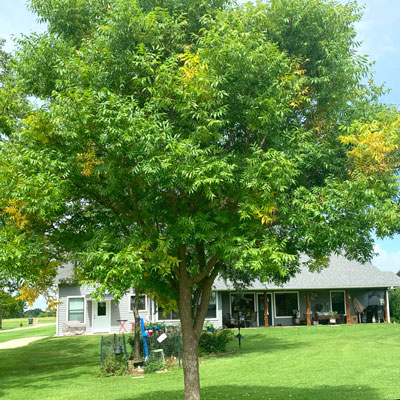
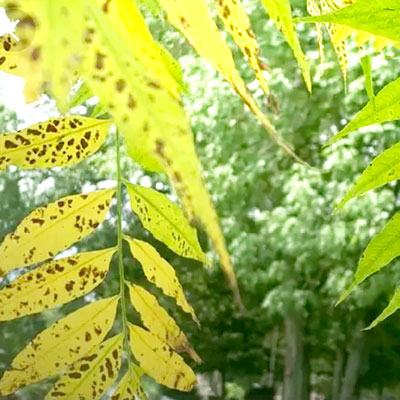
Answer: It would be easy to say that your tree has a fungal leaf spot, but I really don’t think that it does. I just spent 20 minutes searching key words “university plant pathology Pistacia chinensis” online and I found no matches – no diseases worth mentioning. I wonder if this might be due to some failure to get water up to the top of the tree. It looks like there are a lot of competing branches crowded together in the center of the tree, similar to what we see with Bradford pears as they mature. That can pinch off the flow of water and nutrients to branches that are served by the compromised limbs. There might even be active decay within one or more of those branches. I can’t see anything in the photos. Normally I would expect leaf spots to show up on green leaves and then cause them to turn yellow. It looks like these leaves turned yellow first. My suggestion would be that you inspect the trunk as closely as you can and then just watch the tree the balance of this season. Hopefully it’s just a short-term, isolated situation.
QUESTION 3
WHY IS MY JUNIPER HEDGE DEVELOPING THESE BROWN SECTIONS?
Question: For the past 7 years my juniper hedge has been beautiful. Now I’m getting these brown spots popping up, yet other sections are growing just fine. Do you have any other recommendations? Sandy S., Allen.
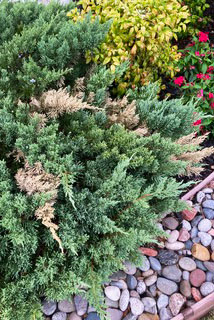
Answer: As I cropped your photo three thoughts crossed my mind:
1. I’ve seen bagworms cause this kind of tip death. They tie their bags around the twigs one spring, and by the following spring the small twigs become girdled by the tough fibers as they try to grow and expand. But I don’t see any evidence of old bags on your plants, so I don’t think that’s it.
2. Spider mites are also a strong possibility. Clip one of these twigs off, bringing 1-2 inches of healthy growth with it. Thump the whole mass over a sheet of white paper in a still, bright place. Look for very tiny, paprika-colored specks to start moving. If you see those, they are the spider mites. They’re very common on junipers, and they can cause the death of even large plants. Apply a general-purpose insecticide that is also labeled for control of spider mites. Spray with fairly strong pressure to saturate the twigs. Check 10 days later for live mites. If they’re still there, repeat the spray.
3. Juniper twig blight is the final possibility. Hopefully this is not the problem because it is quite hard to eliminate. Here is a link to very useful information from Clemson University.
QUESTION 4
CAN I USE IMAGE ON NEW BERMUDA SOD?
Question: I planted bermuda sod on June 15, 2024, after using a herbicide. In a few areas nutsedge has returned. Can I use Image on nutsedge now, or should I wait until the sod goes through its first winter? William T., Waco.
Answer: Absolutely wait until it has gone through its first winter. Image is a growth retardant. That’s the last thing you want to do to new sod. You’ll have ample time next year between May 15 and September 15.
QUESTION 5
CAN I PRUNE THE JAPANESE MAPLE BY MY FRONT DOOR?
Question: The Japanese maple by my front door has outgrown its space. Can it be trimmed back or even topped some this winter? Michael G., Mansfield.
Answer: Japanese maples are used for bonsais, so I guess in theory you could. However, I fear it would really look mangled. You do need to do something, because I’ll bet the sunlight is going to burn its top off as it extends up and over the roofline of your house.
Might you consider transplanting it out to the front corner of your house? Replant it 8 or 10 feet out from the corner to anchor the bed. That could be either at the boundary of the bed edging or even a foot or two out into the grass. Then you could plant an intermediate holly back in that corner. A dwarf Burford would be pretty if allowed to grow to 5 ft. tall, or you could plant an Oakland or Willowleaf holly and allow either to grow to 7 or 8 ft. tall. If you did the latter you would want to move the bird bath forward by a couple of feet. Nice job on your landscape!
QUESTION 6
DO PATHOGENS DEVELOP RESISTANCE TO CERTAIN CONTROL MEASURES?
Question: You often recommend Azoxystrobin to control certain turf problems. I’ve read that pathogens can develop resistance to certain control measures and that different classes of fungicides should be alternated. Do you agree with this? Colleen J., Bryan.
Answer: That probably could happen. However, there’s another issue that weighs in on my answers. There aren’t a lot of turfgrass fungicides left available on the consumer market. While professional applicators may have more classes from which they can choose, home gardeners have very limited selections. And, add to that the fact that our three most common lawn diseases, take all root rot, gray leaf spot, and brown patch, overlap in their seasons and, to a large degree, in their appearance, it’s sometimes hard for a parttime gardener to tell which problem they actually have. When there is one fungicide that can be used on all three it makes answering the questions a lot simpler. At this point I’m not aware of problems of resistances with Azoxystrobin.
QUESTION 7
WHAT HAS HAPPENED TO MY WHITE ADORE HYDRANGEA?
Question: A few days ago, this bush was green and lush. This damage seemed to appear overnight! I see no evidence of insects, and there have been no changes in watering and no chemical treatments. Betty M., Keller.
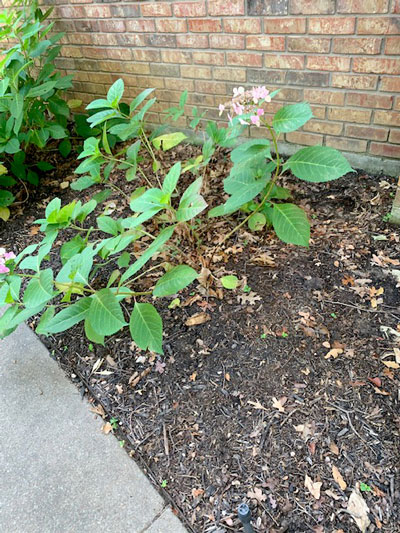
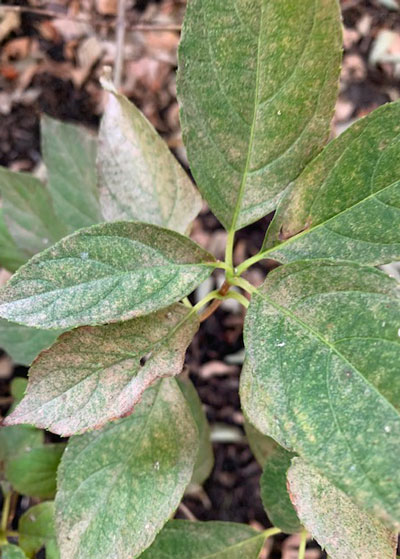
Answer: We changed from moderately cool, moist weather to hot summertime about that time. Your closeup photo looks like it’s had lacebugs on the leaves. If you see black, waxy specks on the backs of the leaves, that would be the evidence to confirm them. Otherwise, I’ll bet your plant just got too dry one time after the rains. The soil looks pretty much like our native black gumbo clay. If so, that’s not hydrangeas’ favorite. That might be a big part of the problem. The next time you try one plant it in very highly organic soil 18 to 20 in. deep and an equal distance across and with sun until mid-morning, then shade the rest of the day. Keep it moist (but not wet) at all times.
QUESTION 8
WILL CANNAS SURVIVE WINTER AT WATER’S EDGE IN NORTH CENTRAL TEXAS?
Question: I planted cannas at lake’s edge this spring and I’m wondering if I need to dig them back out for the winter. Dave, Bowie, Montague County.
Answer: This call actually came to my statewide radio program Saturday morning. I told Dave I would call someone who would know better than I about cannas in wetland settings and post the answer for him and all who were listening to see. I spoke with Allan Traveland at Dickson Brothers in Mesquite. He and his wife Mary and their team are suppliers of everything related to pools, ponds, and water gardens, including aquatic plants. Allan told me that cannas should survive most winters in poolside settings in North Central Texas – much better in the ground as Dave has his than if they were in containers. Green-leafed types, as most of us have discovered, are more winter-hardy than the variegated types. Of course, extreme cold such as we experienced in February 2021 can do serious damage to any of them. Let’s hope we don’t experience that for many years again.

